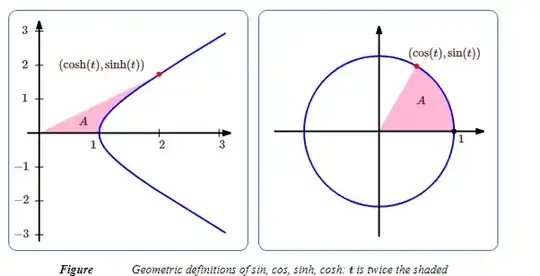The connecting factor amongst the hyperbolic and circular functions and the unit circle and hyperbola is not the angle subtended by the curve but rather the area bounded by it. Here are two images I pulled from the internet:


Consider the point $\mathrm H(\cosh w, \sinh w)$ on the unit hyperbola and the point $\mathrm C(\cos z, \sin z)$ on the unit circle, both plotted on the $xy$-plane. Then
- $w$ equals twice the area bounded by $\rm OH$, the hyperbola, and the $x$-axis,
and since the area of the unit circle is $\pi(1)^2=\pi$, then
- $z$ equals twice the area bounded by $\rm OC$, the circle, and the $x$-axis.
So to summarize, the relationship amongst the argument $t$ of any of the aforementioned functions and the area $a$ bounded by their characteristic locus is $t=2a$.
You mention “arc length covered as you move along the unit hyperbola.” Let’s consider the integral formula for arc length
$$L = \int_\alpha^\beta\sqrt{\left(\frac{dx}{dt}\right)^2+\left(\frac{dy}{dt}\right)^2}\,dt$$
and compare the arc length $L(\mathrm H(T))$ traced along the unit hyperbola from point $(1,0)$ to $(\cosh T, \sinh T)$ and the arc length $L(\mathrm C(T))$ traced along the unit circle from point $(1,0)$ to $(\cos T, \sin T)$:
$$\begin{align}
\mathrm H
&: \begin{cases} x=\cosh t \\ y=\sinh t\end{cases} \\[2ex]
&: \begin{cases} {dx}/{dt} = \sinh t \\ {dy}/{dt} = \cosh t\end{cases}
\\[4ex]
\mathrm C
&: \begin{cases} x=\cos t \\ y=\sin t\end{cases} \\[2ex]
&: \begin{cases} {dx}/{dt} = -\sin t \\ {dy}/{dt} = \cos t\end{cases}
\end{align}$$
So
$$L(\mathrm H(T)) = \int_0^T \sqrt{ \cosh^2 t + \sinh^2 t } \, dt$$
$$L(\mathrm C(T)) = \int_0^T \sqrt{ \cos^2 t + \sin^2 t } \, dt$$
Now invoke the identities $\sin^2t+\cos^2t = 1$ but $\sinh^2t+\cosh^2t = \exp2t-\sinh(t)\cosh(t)$ and you will see that
$$L(\mathrm C(T)) = \int_0^T \sqrt{ 1 } \, dt = t\bigr|_0^T = T$$
$$\begin{align}
L(\mathrm H(T)) &= \int_0^T \sqrt{ e^{2x} - {e^x-e^{-x}\over2} \cdot {e^x+e^{-x}\over2} } \, dt \\[2ex]
&= \int_0^T \sqrt{ e^{2x} - {e^{2x}-1-1-e^{-2x}\over4} } \, dt \\[2ex]
&= \int_0^T \sqrt{ {4e^{2x} - e^{2x}+2+e^{-2x}\over4} } \, dt \quad \cdots
\end{align}$$
Does that help you see why the nice relationship seen between $t$ and $L(\mathrm C(T))$ does not emerge with $t$ and $L(\mathrm H(T))$?

